OIL:
An Optical Interconnect Library for
CAD and On-chip Opto-Electrical Interconnect Planning
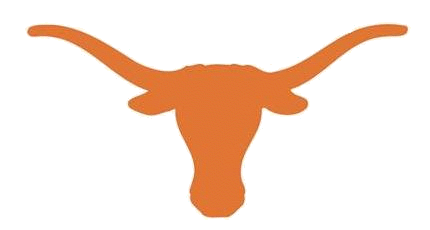
Authors:
Duo Ding and
Prof. David Z. Pan
Introduction


OIL is an Optical Interconnect Library with nanophotonics devices and interconnect models characterized/parameterized
for systematic and quantitative design explorations (architectural and physical designs) utilizing on-chip nanophotonic links.
As an extensible library, current OIL includes on-chip optical modulators, photodetectors, buffers, switches, couplers,
optical waveguide model and some on-chip WDM devices. Based on recent advancement in nano-photonics fabrication technique,
OIL contributes to a closer collaboration between device fabrication, architecture design and CAD optimization towards feasible giga-scale opto-electronics on-chip integration.
Downloads
NOTE: The current version is OIL1.0

Detailed list of current OIL characterized devices (parameter model(PM)/RSoft format model(RM)/FDTD simulation data(FDTD)):
OIL
Device Models
| Model
Alias
| Nanophotonics Modulators
| Nanophotonics Photo-detectors
| Couplers/Switches
| WDM devices and OWG
| Reference
Publications
|
|---|
Parameter
Model | RSoft
Model | FDTD
data
| Parameter
Model | RSoft
Model | FDTD
data
| Parameter
Model | RSoft
Model | FDTD
data
| Parameter
Model | RSoft
Model | FDTD
data
|
|---|
| OIL_001 | mod_MzM1
| PM_001 | RM_001 | FDTD_001
| | |
| | |
| | |
| X. Chen, OE2009
|
| OIL_002 | mod_MzM2
| PM_002 | RM_002 | FDTD_002
| | |
| | |
| | |
| Y. Jiang, APL2005
|
| OIL_003 | mod_MzM3
| PM_003 | RM_003 | FDTD_003
| | |
| | |
| | |
| L. Gu, IEEE08
|
| OIL_004 | mod_MzM4
| PM_004 | RM_004 | FDTD_004
| | |
| | |
| | |
| W.M.J Green OSA07
|
| OIL_005 | mod_Ring1
| PM_005 | RM_005 | FDTD_005
| | |
| | |
| | |
| L. Martinez, OSA06
|
| OIL_006 | mod_Ring2
| PM_006 | RM_006 | FDTD_006
| | |
| | |
| | |
| Q. Xu, OE07
|
| OIL_007 | mod_Ring3
| PM_007 | RM_007 | FDTD_007
| | |
| | |
| | |
| F. Xia, Nature07
|
| OIL_008 | mod_Ring4
| PM_008 | RM_008 | FDTD_008
| | |
| | |
| | |
| S. Manipatruni, OE10
|
| OIL_009 | detector1
| | |
| PM_009 | - | -
| | |
| | |
| M. Oehme, APL06
|
| OIL_010 | detector2
| | |
| PM_010 | - | -
| | |
| | |
| T. Yin OSA07
|
| OIL_011 | detector3
| | |
| PM_011 | - | -
| | |
| | |
| O. G. Memis OSA08
|
| OIL_012 | detector4
| | |
| PM_012 | - | -
| | |
| | |
| L. Chen OE08
|
| OIL_013 | detector5
| | |
| PM_013 | - | -
| | |
| | |
| P.Dong, OE09
|
| OIL_014 | detector6
| | |
| PM_014 | - | -
| | |
| | |
| L. Chen, OE09
|
| OIL_015 | detector7
| | |
| PM_015 | - | -
| | |
| | |
| S. Assefa, Nature10
|
| OIL_016 | coupler1
| | |
| | |
| PM_016 | RM_016 | FDTD_016
| | |
| RSoft Simulator
|
| OIL_017 | coupler2
| | |
| | |
| PM_017 | RM_017 | FDTD_017
| | |
| RSoft Simulator
|
| OIL_018 | switch1
| | |
| | |
| PM_018 | RM_018 | FDTD_018
| | |
| RSoft Simulator
|
| OIL_019 | switch2
| | |
| | |
| _ | _ | _
| | |
| RSoft Simulator
|
| OIL_020 | AWG_4X
| | |
| | |
| | |
| PM_020 | RM_020 | FDTD_020
| RSoft Simulator
|
| OIL_021 | AWG_8X
| | |
| | |
| | |
| PM_021 | RM_021 | FDTD_021
| RSoft Simulator
|
| OIL_022 | AWG_16X
| | |
| | |
| | |
| PM_022 | RM_022 | FDTD_022
| P. Dumon OSA06
|
| OIL_023 | WDM_16X
| | |
| | |
| | |
| PM_023 | RM_023 | FDTD_023
| RSoft Simulator
|
| OIL_024 | WDM_32X
| | |
| | |
| | |
| PM_024 | RM_024 | FDTD_024
| RSoft Simulator
|
| OIL_025 | OWG-straight
| | |
| | |
| | |
| PM_025 | RM_025 | FDTD_025
| RSoft Simulator
|
| OIL_026 | OWG-bend
| | |
| | |
| | |
| PM_026 | RM_026 | FDTD_026
| RSoft Simulator
|
Cu interconnect delay modelings and SPICE simulations assume 22nm technology global (metal5/6) Cu interconnect.
MOSFET models employed for optimal repeater insertion and sizing are: PTM_22nm_PMOS and PTM_22nm_NMOS
Thermal Effects
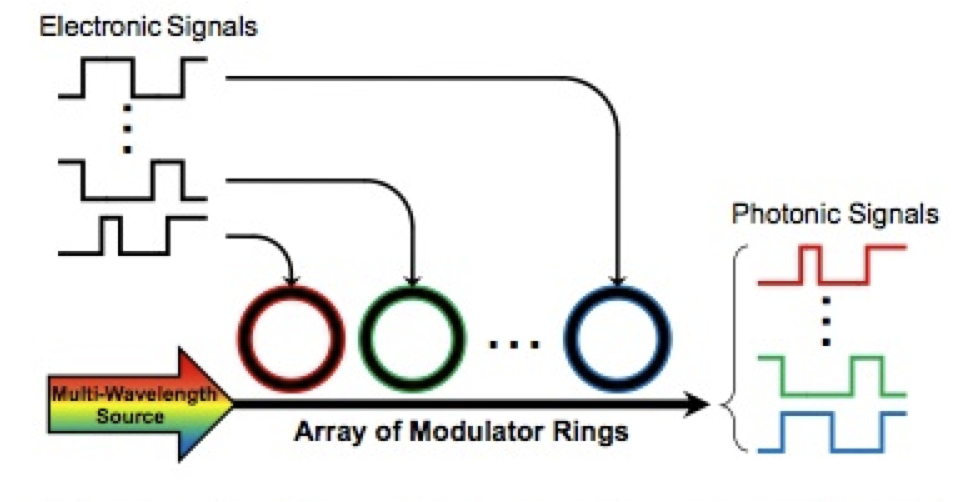
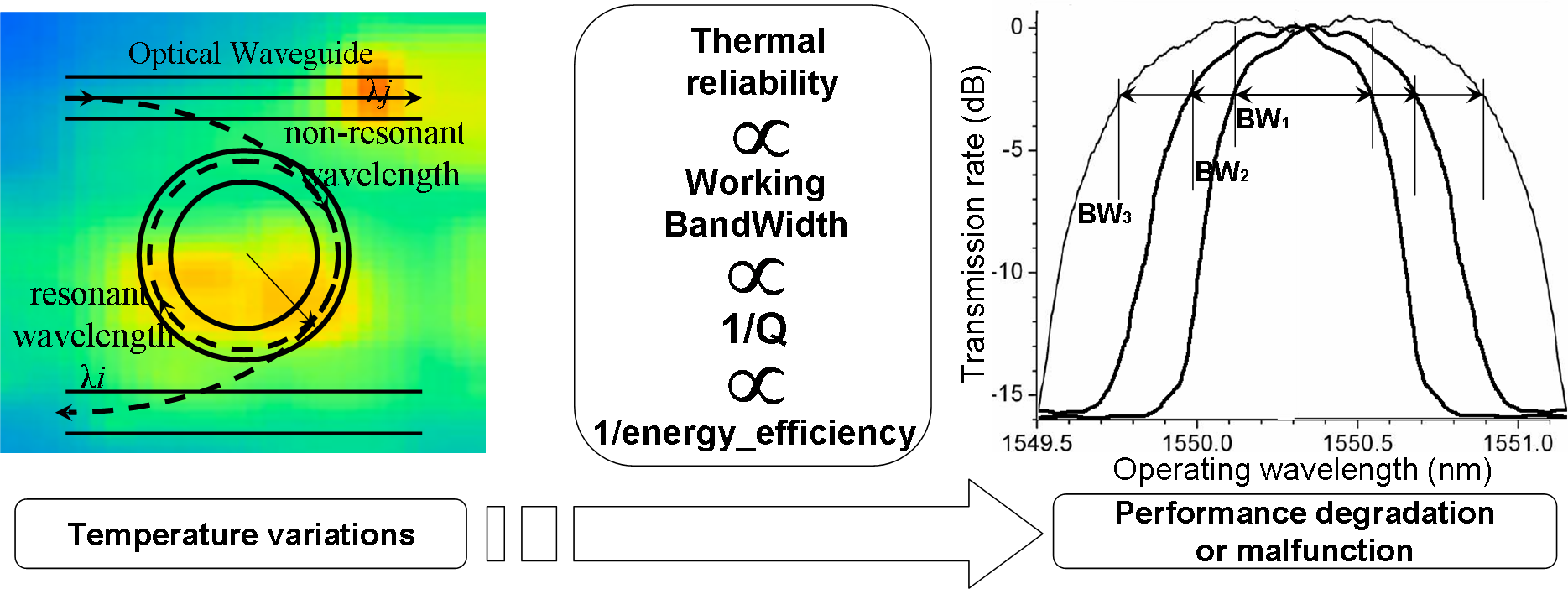
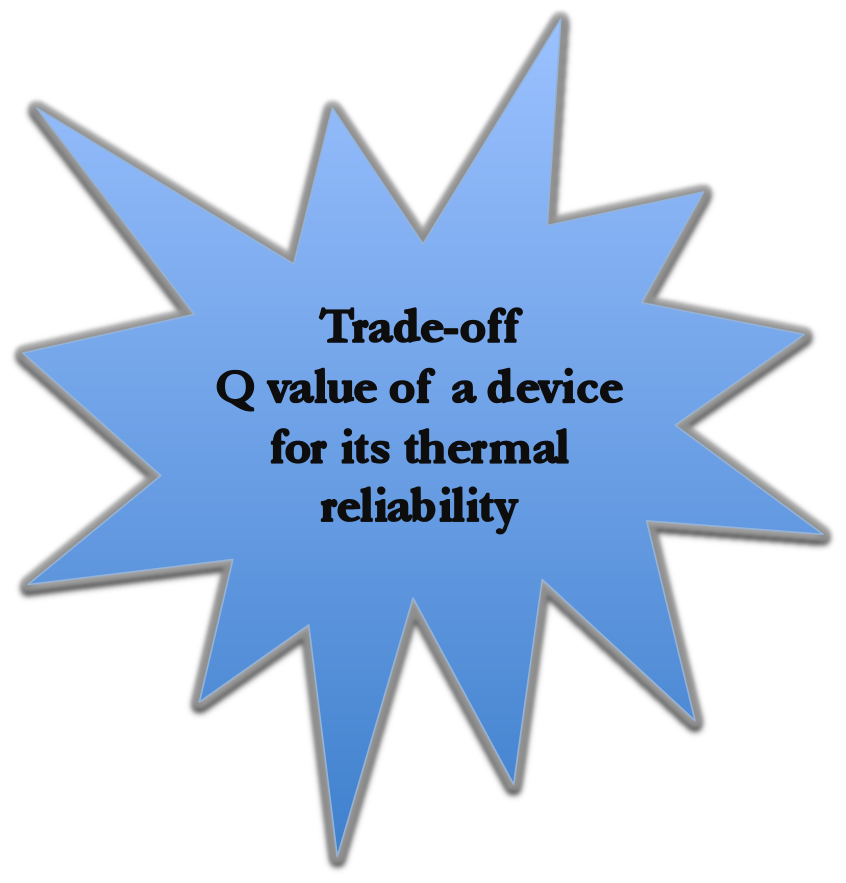
Current on-chip WDM techniques mainly fall into the following categories: AWG (array waveguide) based, ring resonator based and thin film filter based, among which ring resonator cavity based add-drop filter techniques are most widely employed in architecture designs due to its compact footprint (potential ultra density) and demonstrated high quality factor (Q factor). In OIL, we characterize and model on-chip nanophotonics WDM devices enabled by cavity based structure, with respect to power, loss, channel density, working bandwidth and thermal reliability.
Every type of nanophotonic devices is prone to thermal variation with a certain degree, especially ring resonator based structures that are widely employed in currently demonstrated works.
Specifically, on-chip temperature fluctuation causes the central operating frequency (wavelength) of a photonic device to drift. If such a drift results in an off-set that falls outside the range of operating bandwidth (BW), the device will degrade or even malfunction. Especially for high energy efficiency on-chip UDWDM devices with ring resonator structure, the quality factor Q (defined as the energy stored in the cavity versus the energy dissipated per unit cycle) is very high and BW is very narrow, rendering the devices highly sensitive to ambience thermal variations.
The relationships between thermal reliability, device operating bandwidth, quality factor Q and energy efficiency are illustrated in the figure above.
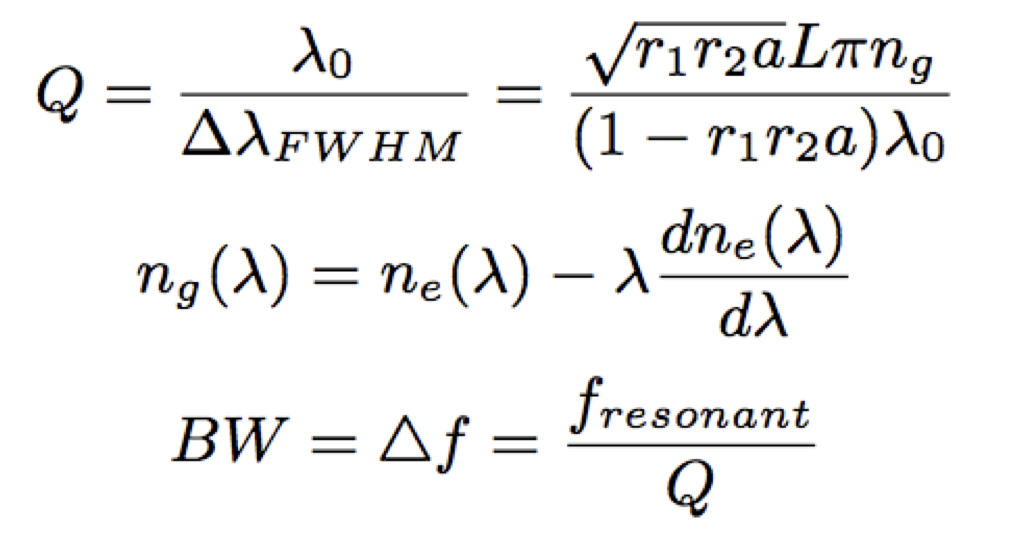
In the equations above, r1, r2, a, L are ring geometry related parameters, lambda is the central working(resonant) wavelength of the ring modulator or detector. n_e is a temperature dependent term, denoting the refractive index of the ring material (e.g., silicon). From the above discussions we can observe that within a relatively small range, one can trade-off Q value for thermal reliability of a certain ring resonator device, without causing aliasing issues in-between of separate channels on a WDM waveguide. However, such a trade-off comes at a power loss penalty that needs to be minimized for power efficient designs.
Based on the comprehensive modeling, we investigate and establish the thermal reliability models for WDM related devices that are mainly based on cavity based components (e.g., ring resonators and ring couplers). The thermal reliability models are obtained through exhaustive temperature dependent refractive index modeling/simulation, working bandwidth characterization, power consumption/dissipation simulation and numerical methods such as Finite-difference Time-domain (FDTD) device simulations on powerful computing platforms using RSoft CAD Simulator.
Basics and Formats

+ Syntax, Short-hand terms and acronyms used in OIL:
-
layer definition sections (geometries of each device):................................"LAYER# .... END LAYER#"
parameter summary section (performance and timing data):..................."TOP .... END TOP"
- DR : data (modulation/transmission/detection) rate in...............................'Giga bits per second'
BER: bit error rate (modulation/transmission/detection) in...............................'probability of occurrence'
BL : total bending loss of certain (e.g. ring resonator, Waveguide Coupler, etc.) structure in......'dB'
BR : bending radius of certain (e.g. ring resonator) structure
BW : signal bandwidth in......................................................................'Giga Hz'
3dBBW : 3dB signal bandwidth in......................................................................'Giga Hz'
CIN: input port equivalent capacitance in....................................................'pF'
CG : coupling gap between two optical channels (e.g., when ring resonator couples with OWG)
CL : coupling loss between two optical channels (e.g., when ring resonator couples with OWG)
Tau: signal delay on certain device in.........................................................'ps'
EbC: electrical power consumption per bit (dynamic power) in..............................................'pico-J per bit'
EC : electrical power consumption (DC + dynamic power) in...........................................................'mW'
ER : extinction ratio between optical "1" and "0" in......................................'dB'
OCL: on-chip optical loss in (dB = -10*log{10}{Pow_out/Pow_in})............'dB'
WW : working wavelength 'lamda' in............................................................'nm'
dWW: delta working wavelength (3dB stability range of WW) in..................'nm'
MAT: materials used for certain layer# (Si, Ge, GaAs, etc.)
LEN: length of a certain geometry in..........................................................'um' (micron)
WID: width of a certain geometry in............................................................'um' (micron)
THI: thickness of a certain geometry in......................................................'um' (micron)
IND: refractive index of a certain geometry/layer
PCR: radius of the photonic crystal structure (hole shaped structures)
PCI: refractive index of the photonic crystal structure (hole shaped structures)
PL: passing loss of certain coupling devices in the unit of..................'dB'
VB: DC bias employed of certain active device (MzM mod or Ring mod, etc.)
-
OWG: on-chip optical waveguide
OIL: nanophotonics Optical Interconnect Library
MzM: Mach-Zehnder structure
PM: Parameter Model of a certain device characterized in OIL syntax/key words
RM: RSoft Model of a certain device characterized in RSoft-CAD suite syntax/key words
Ring: Ring cavity based structure
FDTD: Finite-difference Time-domain technique
FDTD data: Device simulation data using RSoft FDTD CAD environment
WDM: Wavelength Division Multiplexing technique
CMOS: Complementary metal-oxide-semiconductor
NoC: Networks-on-Chips
m sec: 1e-3 sec
u sec: 1e-6 sec
n sec: 1e-9 sec
p sec: 1e-12 sec
+ To be further updated soon!
Related Publications
♦
Duo Ding,
Bei Yu and David Z. Pan,
"GLOW: A Global Router for Low-Power Thermal-reliable Interconnect Synthesis using Photonic Wavelength Multiplexing",
IEEE (Intl.) Asia and South Pacific Design Automation Conference (ASPDAC), Jan., 2012 (IEEE source)
♦Duo
Ding
and David Z. Pan,
"OIL: A Nanophotonic Optical Interconnect Library for a New Photonic Networks-on-Chip Architecture",
International Workshop on System Level Interconnect Prediction (SLIP),
California, July 2009 (ACM source)
♦
Duo Ding,
Yilin Zhang, Haiyu Huang, Ray T. Chen and David Z. Pan,
"O-Router: An Optical Routing Framework for Low Power On-Chip Silicon Nano-Photonic Integration",
Design Automation Conference (DAC) 2009 (IEEE source)
+How to cite:
If you like the contents of this webpage and would like to apply OIL and related models in your works,
please free feel to cite our SLIP paper "OIL: A Nanophotonic Optical Interconnect Library for a New Photonic Networks-on-Chip Architecture"
Related Links
- On-Line books for Semiconductor Devices:
Principles of Semiconductor Devices:
http://ecee.colorado.edu/~bart/book/contents
- Refractive Index Database of Semiconductor Materials:
FILMETRICS:
http://filmetrics.com
- Useful OpenSource Software for Semiconductor Device Simulations:
General-purpose Semiconductor Simulator:
GSS-TCAD
- Electrical Routing
tools:
BoxRouter: Prof. David Z. Pan:
http://www.cerc.utexas.edu/utda/download/BoxRouter
FGR: Prof. Igor Markov:
http://vlsicad.eecs.umich.edu/BK/FGR/
FLUTE: Prof. Chris Chu:
http://home.eng.iastate/~cnchu/flute
MaizeRouter: by Michael D. Moffitt:
http://www.eecs.umich.edu/~mmoffitt/MaizeRouter
NTHU-Route2.0: Prof. Ting-Chi Wang:
http://www.cs.nthu.ed.utw/~tcwang/nthuroute
- Cell-based
Placement tools:
CAPO: Prof. Igor Markov:
http://vlsicad.eecs.umich.edu/BK/PDtools/Capo
mPL6: Prof. Jason Cong:
http://cadlab.cs.ucla.edu/cpmo/
-
Software packages free for academic research (students):
GLPK:
http://www.gnu.org/software/glpk/
MOSEK:
http://www.mosek.com/
STLPORT:
http://sourceforge.net/projects/stlport
Launched April 2010 by Duo Ding









